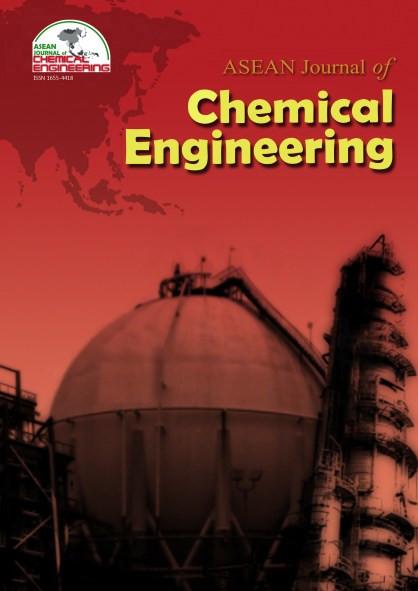Mathematical Model for the Prediction of Gas-Liquid Mass Transfer in Airlift Contactors
Abstract
A mathematical model was proposed to explain the gas-liquid mass transfer behavior in an airlift contactor (ALC). The model separated the airlift contactor into three sections: riser, gas separator, and downcomer. The riser and downcomer were described using the dispersion model whilst the gas separator was modeled as a .completely mixed tank. All parameters needed for the model were obtained from independent experiments both carried out in this work and reported elsewhere. Simulation results were compared with a number of experimental data obtained from the systems with various geometrical and operational conditions. It was shown that the model could predict the oxygen mass transfer between phases in the ALC with reasonable accuracy. Keywords: Airlift contactor (ALC), dispersion model, mass transfer, mathematical model, and verification.References
2. Camarasa, E., Meleiro, L. A. C., Carvalho, E., Domingues, A., Fiho, R. M., Wild, G., Poncin, S., Midoux, N., and Bouillard, J. (2001). "A complete model for oxidation air-lift reactors," Comp. Chem. Eng., 25, 577-584.
3. Chapra, S. C., and Canale, R. P. (1998). Numerical methods for engineers with programming and software applications, 3rd ed., McGraw-Hill, New York. Chisti, Y. (1998). "Pneumatically agitated bioreactors in industrial and environmental bioprocessing: Hydrodynamics,” Appl. Mech. Rev., 51, 33–112.
4. Chisti, Y., and Moo-Young, M. (1987). "Airlift reactors: Characteristics, applications and design considerations," Chem. Eng. Commun, 60, 195–242.
5. Chişti, M. Y., Halard, B., and Moo-Young, M. (1988). “Liquid circulation in airlift reactors," Chem. Eng. Sci., 43, 451-457.
6. Choi, K. H. (1999). "A mathematical model for unsteady-state oxygen transfer in an external-loop airlift reactor," Korean. Chem. Eng., 16, 441-448.
7. Dhaouadi. H., Poncin, S., Hornut, J. M., Wild. G., Oinas, P., and Korpijarvi, J. (1997). "Mass transfer in an external-loop airlift reactor: Experiments and modeling," Chem. Eng. Sci., 52, 3909–3917.
8. Dhaouadi. H., Poncin, S., Midoux, N., and Wild, G. (2001). "Gas-liquid mass transfer in an airlift reactor-Analytical solution and experimental confirmation," Chem. Eng. Proc., 40, 129-133.
9. Koide, K., Kurematsu, K., Iwamoto, S., Iwata, Y., and Horibe, K. (1983a). "Gas holdup and volumetric liquid-phase mass transfer coefficient in bubble column with draught tube and with gas dispersion into tube," J. Chem. Eng. Japan, 16, 413-419.
10. Koide, K., Sato, H., and Iwamoto, W. (1983b). "Gas holdup and volumetric liquid-phase mass transfer coefficient in bubble column with draught tube and with gas dispersion into annulus," J. Chem. Eng. Japan, 16, 407-413
11. Korpijarvi, J., Oinas, P., and Reunanen, J. (1999). “Hydrodynamics and mass transfer in an airlift reactor," Chem. Eng. Sci., 54, 2255-2262.
12. Lindert, M., Kochbeck, B., Prüss, J., Warnecke, H.-J., and Hempel, D.C. (1992). "Scale up of airlift-loop bioreactors based on modeling the oxygen mass transfer," Chem. Eng. Sci., 47, 2281-2286.
13. Mangartz, K.-H., and Pilhofer, T. H. (1981). “Interpretation of mass transfer measurements in bubbie columns considering dispersion of both phases," Chem. Eng. Sci., 36, 1069--1077.
14. Merchuk, J. C., and Gluz, M. (1999). "Bioreactors, airlift reactors," Flickinger, M.C. and Drew, S.W., eds., Encycolpedia of bioprocess technology: Fermentation, biocatalysis and bioseparation, vol. 1. Wiley, New York, 320-353.
15. Merchuk, J. C., and Stein, Y. (1981). "Local hoid up and liquid velocity in airlift reactors," AICHE J., 27, 377–388.
16. Merchuk, J. C., Contreras, A., Garcia, F., and Molina, E. (1998). "Studies of mixing in a concentric tube airlift bioreactor with different spargers," Chem. Eng. Sci., 53, 709-719.
17. Moustiri, S., Hebrard, G., Thakre, S. S., and Roustan, M. (2001). "A unified correlation for predicting liquid axial dispersion coefficient in bubble columns," Chem. Eng. Sci., 56, 1041-1047.
18. Rüffer, H. M., Liwei Wan, Lübbert, A., and Schügerl, K. (1994). "Interpretation of gas residence time distributions in large airlift tower loop reactors," Bioproc. Eng., 11, 153-159.
19. Tung, H.-L., Tu, C.-C., Chang, Y.-Y., and Wu, W. T. (1998). "Bubble characteristics and mass transfer in an airlift reactor with multiple net draft tubes," Bioproc. Eng., 18, 323–328.
Copyright holder for articles is ASEAN Journal of Chemical Engineering. Articles published in ASEAN J. Chem. Eng. are distributed under a Creative Commons Attribution-NonCommercial 4.0 International (CC BY-NC 4.0) license.
Authors agree to transfer all copyright rights in and to the above work to the ASEAN Journal of Chemical Engineering Editorial Board so that the Editorial Board shall have the right to publish the work for non-profit use in any media or form. In return, authors retain: (1) all proprietary rights other than copyright; (2) re-use of all or part of the above paper in their other work; (3) right to reproduce or authorize others to reproduce the above paper for authors’ personal use or for company use if the source and the journal copyright notice is indicated, and if the reproduction is not made for the purpose of sale.



